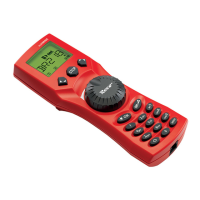56
TERMINAL LOOPS IN DIGITAL OPERATION
Every model railway enthusiast knows the problem of terminal loops from his / her conventional system. In
digital operation too, the left-hand rail profile meets the right-hand rail profile after a terminal loop and
would cause a short circuit without the appropriate wiring.
The ROCO 10769 terminal loop module solves the problems of a terminal loop in digital operation. Isolate
the terminal loop with both poles on both sides by disconnecting the terminal loop completely from the
rest of the system, using either insulated connectors or by sawing the rail profiles (see fig. 5 on page 64).
It is imperative that the isolated section of track within the terminal loop is longer than the longest train
which is going to travel through the terminal loop. The power supply to the terminal loop is connected to
the output of the terminal loop module which provides the power supply for the terminal loop. The module
itself is connected either to a track outside the terminal loop or directly to the amplifier.
The terminal loop module functions as follows: A train enters the terminal loop – the direction is not
important – and the polarity of the tracks before and within the terminal loop is not identical. There is then
a short circuit within the module which the module immediately detects. The module then reverses the
polarity in the terminal loop before the short circuit detection function of the amplifier detects anything or
the train slows down. The terminal loop polarity is then corrected for the entry of the train. The reverse of
polarity in the terminal loop does of course render the polarity incorrect for the train’s exit from the loop.
This procedure or reversing the polarity is therefore repeated when the train exits. Since in digital operation
the polarity of the tracks do not determine the direction of travel of the train; the train can pass through
the terminal loop without stopping or without your intervention.
In order for the terminal module to detect incorrect polarity in time, you have to set its sensitivity using the
potentiometer visible on the side. See the terminal loop module’s instructions for use.
GLOSSARY
Decoder
In order to make the digital control signals of the
multi
MAUS understandable to “conventional” technology,
you require a “translator” – the decoder. It does not replace any of the components in the analogue direct
current locomotive but is a necessary addition and must also be given a place in the locomotive housing.
For alternating current locomotives on the other hand, the change-over module or relay is replaced by the
decoder, not in DCC format but of course Motorola format.
CVs
All values which affect the behaviour of the locomotive decoder – and ultimately the behaviour of the
locomotive – are stored in what are referred to as CVs. CV is the abbreviation for configuration variables.
The
multi
MAUS is compatible with the NMRA / DCC standard and can therefore read and write these vari-
ables.
ROCO amplifiers 10761 and 10764 and booster 10762 and 10765 cannot be used to read the CVs from
a decoder! The values shown are only fictitious suggested values.
CVs range from “0” to “255”. This shows that reprogramming requires experience, as incorrectly set CVs
may have an adverse effect on the performance of the decoder.
Speed steps
On a conventional model railway a regulating transformer is used to control locomotives. The transformer
emits voltage values to control the locomotive motor between 0 volts and the maximum voltage (typically
between 12 and 16 volts) via the controller.

